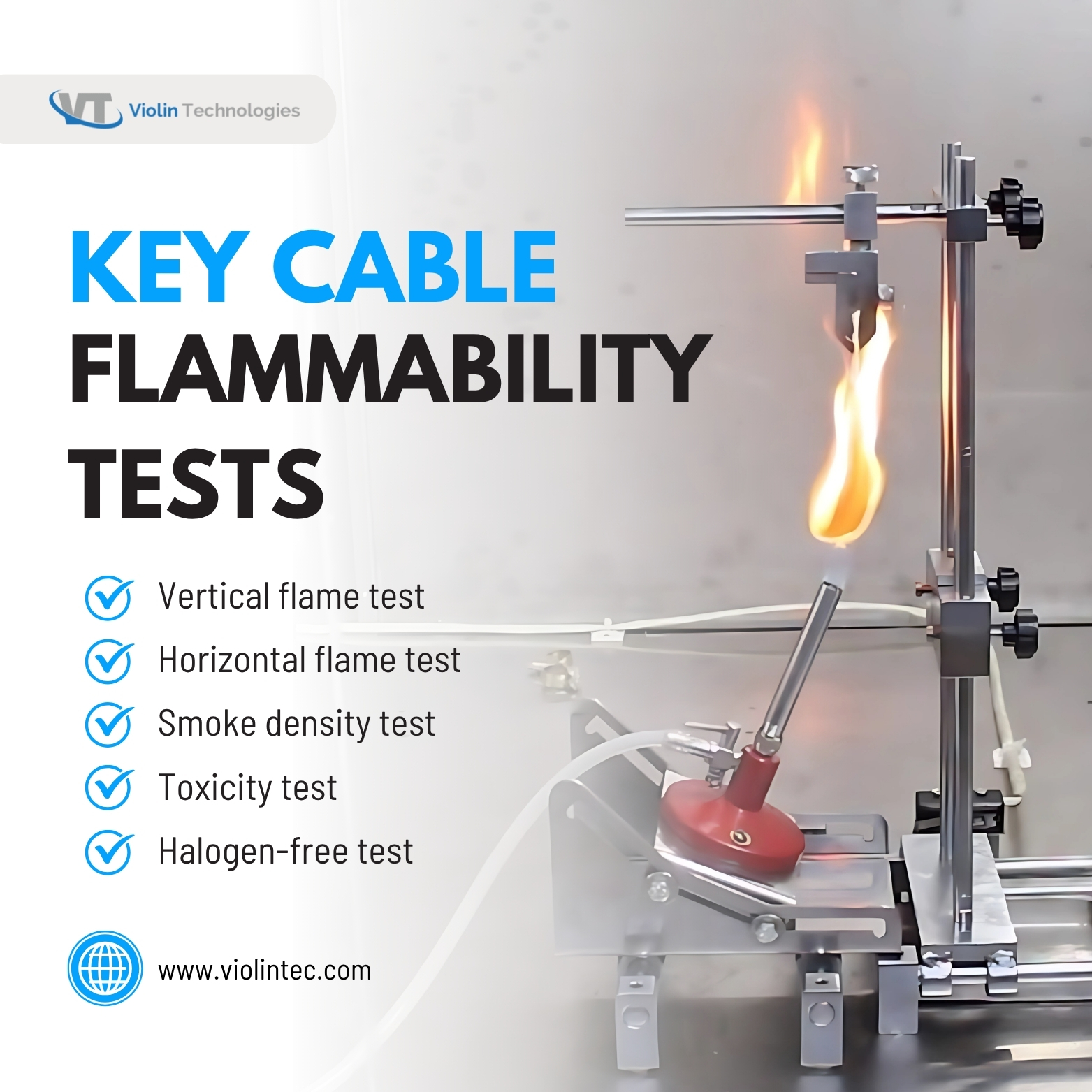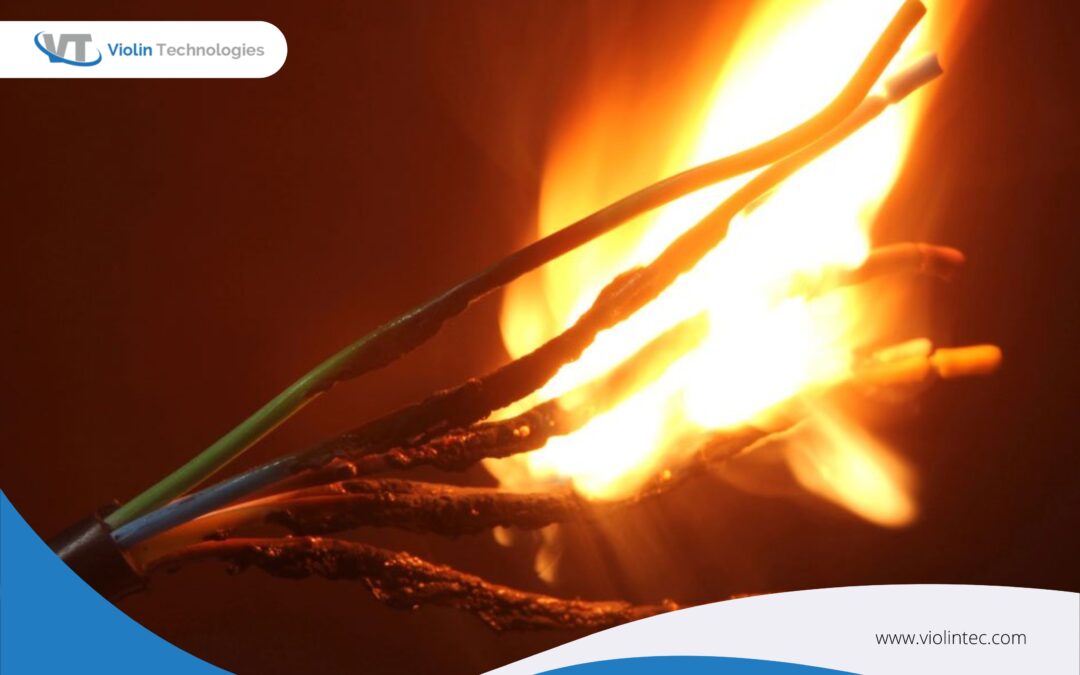This blog post delves deeply into the significance of cable flammability and the essential tests that manufacturers use to assess the safety of cables.
Understanding Cable Flammability
The term “cable flammability” refers to the rate at which a cable can ignite and spread flames. Selecting a fire-resistant cable can make the difference between a small issue and a catastrophic event.
Ignoring flammability regulations can lead to compliance issues, potential legal consequences, and, above all, the loss of life. With businesses relying heavily on automated machinery, where even a small spark can ignite a major fire, cables must possess the right fire-resistant qualities.
Key Cable Flammability Tests
Vertical Flame Test
The Vertical Flame Test is one of the first lines of defense against potential fire threats in cables. This test examines how the cable responds when exposed to a fire source and evaluates its flame-retardant properties. The cable must be mounted in a vertically oriented chamber to perform the Vertical Flame Test.
After applying a prescribed flame for a predetermined amount of time, it is observed whether and how the flame spreads along the cable. The primary objective is to determine whether the flame extinguishes itself or continues to spread.
This test is crucial for custom cable manufacturers seeking to produce cables that meet stringent safety requirements.
Horizontal Flame Test
Like the Vertical Flame Test, the Horizontal Flame Test provides an alternative viewpoint on flammability by examining the spread of flames along horizontally fixed cables. The purpose of the Horizontal Flame Test is to evaluate the fire response of cables arranged horizontally, which is a typical arrangement in many industrial settings.
Manufacturers can determine whether the materials used in cables have the fire-retardant qualities required to withstand lateral flame spread by exposing them to a controlled flame in a horizontal environment.
For individuals working with cable assemblies in the United States, these test findings are particularly helpful, as they ensure compliance with safety regulations.
Smoke Density Test
When it comes to cable flammability, there’s more to consider than simply the flame spread. The Smoke Density Test examines the amount of smoke generated when cables are burned.
This smoke can obscure vision and make it more difficult to evacuate safely in an emergency, posing a potentially dangerous yet hidden threat. To perform a smoke density test, the cable must be enclosed in a chamber and subjected to a flame. A light source and optical sensors are then used to detect the density of the resultant smoke. High-density smoke can pose a fire hazard by blocking visibility, which is crucial in industrial settings with complex machinery and dense worker traffic.
Toxicity Test
When evaluating cable safety, the possible emission of harmful gases during a fire is just as important as the smoke density. When wires burn, toxicity testing assesses the kinds and concentrations of harmful gases that are emitted.
Carbon monoxide, hydrogen chloride, and other substances that can seriously endanger the respiratory system are examples of common hazardous gases. This test is especially important in enclosed industrial areas, where a fire could pose a significant risk to the health of workers.
Plenum Test
The plenum test is conducted in Steiner Tunnel, a specialized horizontal duct with controlled airflow. Cable bundles are positioned within the tunnel and left to burn. Measurements are taken during the test to determine the density of the smoke produced and the distance the flames extend along the cables.
This test, which assesses the cables’ capacity to restrict smoke formation and flame spread in a ventilated environment, is essential for cables meant for use in air handling spaces.
Halogen-Free Test
The Halogen-Free Test, which assesses whether cables are free of halogen components like chlorine, bromine, and iodine, is another crucial test associated with cable flammability. Because they are corrosive, these substances can have severe negative effects on environmental health and human health when released during fires.
By preventing the release of hazardous halogens during combustion, the Halogen-Free Test guarantees that cables stay safe and environmentally friendly. This is especially important for businesses looking to manage their environmental impact sustainably and obtain green certifications.

Smart Options for Custom Cables: A Non-Technical Buyer’s Guide
When placing an order for custom electrical cables, especially for specific applications, it’s important to consider the flammability standards. This is a useful manual for businesses and non-technical people:
Fully Understand Your Application
The initial and crucial step is to have a broad understanding of the area where the customized cable will be installed, as well as the precise application of the cable. Consider the cable’s particular purpose, the electrical demands it will encounter, and any possible risks in its working environment.
Assess the Environment for Installation
Regarding the location of the cable, ask yourself important questions. Will it be held outside or indoors? Will it be visible in public areas or hidden behind walls or ceilings? Is the installation in a plenum—an air handling space used by the building’s HVAC system? Will the cable be a part of a riser or a vertical run that connects floors?
The responses to these questions will have a significant impact on the necessary flammability rating.
Refer to your local building codes and regulations
It is highly advised that you review the construction and electrical codes in your area. The minimum flammability ratings needed for cables used in various kinds of installations are frequently specified by these rules.
Engage with Your Cable Manufacturer
Don’t be afraid to discuss your custom cable requirements openly and in-depth with your custom cable manufacturer. They possess the technical expertise to assist you in selecting the optimal flammability rating and cable materials for your specific application and environment. Prepare to offer them detailed information on how the cable will be utilized and where it will be put.
Verify the safety certification markings.
Always verify that the customized cables you acquire display the certification logos of reputable safety organizations such as UL certification. These indicators ensure that the cable has been independently examined and meets the necessary safety standards.
Final Thoughts
Cable flammability is more than simply a technical issue; it’s about safety, accountability, and peace of mind. Whether you’re building a skyscraper or wiring a house, selecting the right cable and knowing the tests that underpin their ratings can save lives. Next time you see a cable, remember that what’s on the outside is just as important as what’s on the inside.
FAQs
1. Why does cable flammability matter in electrical systems?
Cable flammability impacts fire safety and prevents the spread of flames in the event of an electrical accident.
2. What is the Vertical Flame Test?
It tests how a cable behaves when exposed to a flame from below to determine its potential for self-extinguishment.
3. What does the Smoke Density Test measure?
It determines how much smoke a burning cable generates, which affects visibility and toxicity during a fire.
4. Are flammability-rated wires required for all installations?
They are frequently required in commercial, industrial, and public spaces to meet fire safety regulations.

